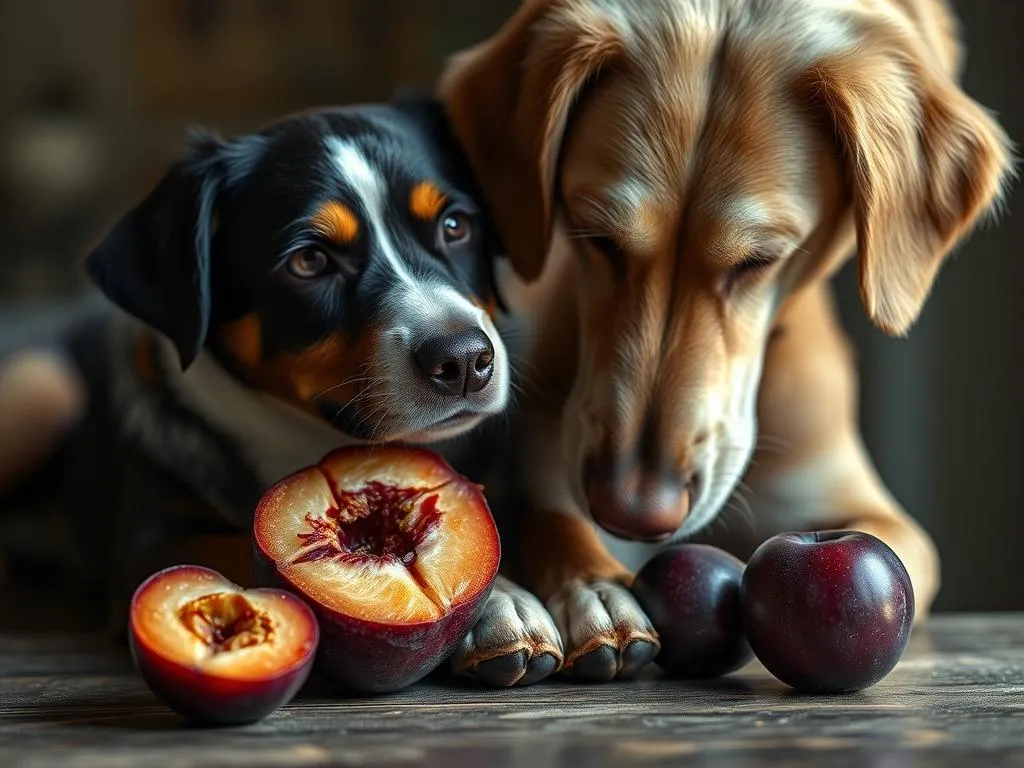
Introduction
Understanding dog nutrition is crucial for any pet owner. Just like humans, dogs require a balanced diet composed of essential nutrients to maintain their health and vitality. With so many foods available, it’s important to know which ones are safe for our furry friends. One question that often arises is: can dogs eat plums? This article delves into this topic, exploring the nutritional profile of plums, the risks involved, and safer alternatives. Let’s dive into the world of dog nutrition to ensure our pets thrive.
Understanding Dog Nutrition
The Basics of Dog Nutrition
Dogs, like all living creatures, require a variety of nutrients to stay healthy. These include:
- Proteins: Essential for muscle development, tissue repair, and overall growth.
- Fats: Important for energy, healthy skin, and absorbing fat-soluble vitamins.
- Carbohydrates: Provide energy and help with digestion.
- Vitamins and Minerals: Critical for various bodily functions, including immune response and bone health.
A balanced diet ensures that dogs receive all these nutrients in the right proportions, which contributes to their overall well-being and longevity.
Common Foods in Dog Diets
Many dog owners rely on commercial dog foods, which come in various formulations. High-quality dog foods typically include:
- Meat and meat by-products
- Grains (like rice and oats)
- Vegetables and fruits
- Vitamins and minerals
While commercial foods can provide a balanced diet, including whole foods and natural ingredients can enhance a dog’s nutrition. Knowing what goes into your dog’s food can help you make informed choices.
The Role of Fruits and Vegetables in Dog Diets
Fruits and vegetables can be excellent additions to a dog’s diet. They offer essential vitamins, minerals, and fiber, promoting good digestion and overall health. Some common fruits and vegetables that are safe for dogs include:
- Apples (without seeds)
- Blueberries
- Carrots
- Sweet potatoes
- Green beans
Incorporating these foods can provide variety and additional nutrients that promote a healthy lifestyle.
Can Dogs Eat Plums?
Nutritional Profile of Plums
Plums are a juicy, nutrient-rich fruit packed with vitamins A and C, potassium, and antioxidants. While they offer numerous health benefits for humans, the question remains: can dogs eat plums?
While dogs can consume the flesh of plums in moderation, it’s essential to understand their nutritional profile and how it compares to human consumption. Plums can provide hydration and some vitamins, but they are not a necessary part of a dog’s diet.
Risks Associated with Feeding Dogs Plums
Despite their nutritional value, there are significant risks associated with feeding dogs plums. Here are some of the primary concerns:
- Pit Toxicity: The pit of a plum contains cyanogenic compounds, which can be toxic if ingested. If a dog were to chew and swallow the pit, it could lead to serious health issues.
- Gastrointestinal Issues: Eating too much of the flesh can cause gastrointestinal upset, leading to vomiting or diarrhea.
- Allergic Reactions: Some dogs may have allergies to certain fruits, including plums. Symptoms can include itching, swelling, or gastrointestinal distress.
Recognizing the signs of plum poisoning or allergic reactions is crucial for responsible pet ownership.
How to Safely Introduce Plums to Your Dog
If you decide to introduce plums into your dog’s diet, follow these guidelines to ensure safety:
- Start Small: Offer a small piece of plum flesh to see how your dog reacts.
- Remove the Pit: Always remove the pit before offering any plum to your dog.
- Monitor Your Dog: Watch for any adverse reactions, such as vomiting or diarrhea, after your dog consumes plums.
- Limit Portions: Keep portions small to avoid gastrointestinal upset.
By adhering to these guidelines, you can safely introduce plums into your dog’s diet while minimizing risks.
Alternatives to Plums
If you’re hesitant about feeding your dog plums due to the associated risks, there are plenty of delicious and safe alternatives. Some safe fruits to offer include:
- Apples: Rich in vitamins and fiber; just remember to remove the seeds.
- Bananas: High in potassium and easy to digest.
- Blueberries: Packed with antioxidants and low in calories.
- Peaches: Safe when the pit is removed, offering vitamins A and C.
These alternatives provide similar nutritional benefits without the risks associated with plums.
Expert Opinions on Feeding Dogs Fruits
Veterinarian Insights
Veterinarians generally agree that fruits can be a healthy addition to a dog’s diet, but they should be given in moderation. Many vets advise pet owners to consult them before introducing new foods, including fruits like plums. This ensures that any potential allergies or health concerns are addressed.
Case Studies/Examples
Several pet owners have shared their experiences regarding feeding plums to their dogs. One owner reported that their dog enjoyed the flesh of a plum but experienced mild gastrointestinal distress after consuming too much. Another case involved a dog that accidentally ingested a plum pit and required veterinary intervention to avoid serious health complications. These cases highlight the importance of caution when introducing new foods to a dog’s diet.
Conclusion
In conclusion, while the question of can dogs eat plums can be answered with a cautious “yes,” it is essential to understand the associated risks. Dogs can enjoy the flesh of plums in moderation, but the pits are dangerous, and some dogs may react negatively. Always prioritize safe and nutritious food choices for your pets. A balanced diet, rich in appropriate fruits and vegetables, will help ensure that your furry friends remain healthy and happy.
FAQs
Can dogs eat other stone fruits?
Stone fruits, like cherries and peaches, can pose similar risks to plums. The flesh is usually safe in moderation, but the pits should always be removed. Always consult a veterinarian before introducing any new stone fruit.
What should I do if my dog eats a plum pit?
If your dog ingests a plum pit, monitor them closely for signs of distress, such as vomiting, lethargy, or abdominal pain. If any concerning symptoms arise, contact your veterinarian immediately.
How can I ensure my dog has a balanced diet?
To maintain a healthy diet for your dog, ensure they receive a variety of nutrients. Incorporate high-quality commercial dog food complemented by safe fruits and vegetables. Always consult your veterinarian for personalized dietary recommendations and remember to introduce new foods gradually.
By prioritizing your dog’s nutrition and being informed about safe foods, you can contribute significantly to their health and happiness.









